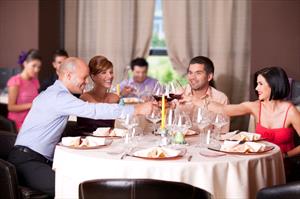two couples dining

White linen tablecloths cover the tables. The lighting is soft, and sophisticated jazz is playing in the back-ground, barely audible. Elegant artwork adorns the walls. Glasses clink, people whisper as they eat their meals. All-in-all, a romantic dinner setting in a nice restaurant.
Unless you’re out to dinner with a veterinarian and his or her friends.
At first, the table talk is pleasant with discussions about weather, sports, children. One could call it benign. Only “benign” is a trigger word. “Benign. Reminds me of a recent case I saw...” And off the rails goes the conversation train, plummeting over the bridge into the chasm below.
The trigger can start as early as the soup course. How can soup be a trigger, you wonder? Because soup is eaten with spoons. And one of the veterinarians starts recounting how in outback Australia he had used a sharpened spoon as a device for enucleating cow eyes (that is, separating the eye from the cow) because of cancerous growths. “Sort of like scooping eyes-cream,” he jokes. Half the table ― not surprisingly, the veterinary half ― laugh uproariously. The other (non-veterinary) half gag on their soup. Immediately, stories of enucleations begin to circulate around the table. Non-veterinary spouses vainly try to steer the conversations to more genteel topics. However, nudging, pinching and out-right punching by these spouses won’t discourage a veterinarian from elaborating, in graphic detail, some gruesome procedure.
Inevitably, during the main course, if the critical veterinary mass is exceeded (and, lamentably, that critical limit can be just one veterinarian), somebody will compare some portion of the meal to gastrointestinal contents or bodily functions. The chef used cayenne pepper in the dish? “We used to have a purgative called Sykes’ Drench that contained cayenne pepper – worked great to clean out blocked-up goats. Made ‘em squirt like fire hoses.” That sort of thing, only in language unsuitable for publication.
The lady ordered Andouille sausage? “Yeah, I had Andouiellette once,” says the veterinarian. “Not the same thing at all as Andouille. Big mistake on my part. Made of intestines. Smelled like thrush [a necrotic fungal infection] on a horse’s foot. Don’t know how the French can eat that stuff.” Suddenly, the lady is sending back her sausage for a salad and contemplating looking for the ladies' room window to escape the oblivious idiot she’s having dinner with. Or maybe the intestinal dish inspires reminiscences of that Labrador that the veterinarian spayed, the one that ruptured her abdominal sutures and proceeded to eat a section of her own intestine before the owners managed to bring her back for the repair. (By the way, the crazy, autophagous Labrador did just fine.)
At other times, the meat on the non-veterinarian’s plate becomes an anatomy specimen. Or worse yet, a pathology specimen. “That there is the calcaneus,” the veterinarian points out with a fork. Hmmm, and you thought you’d ordered lamb shanks. “See that? That’s an articular facet.” So much for that nicely prepared T-bone steak. “That bechemel sauce makes it look like you just cut into a cheesy gland lymph node, full of pus.“ Okay, how about something with pesto instead? (No. Pesto looks just like ruminal [cow stomach] contents.) "Hey, look how the nerves pass through these small foraminae out of the spinal cord.” Guess you didn’t really want that ox-tail stew anyway.
Oh, how dangerous a little knowledge is.
Sashimi and sushi sound good until the veterinarian across the table from you points out that the ocean trout on your plate could contain anasakis. Look it up. It’s not pleasant. Or that improperly prepared fugu (puffer fish) contains tetrodotoxin, which can be used to study sodium channels, but also kills you in minutes if consumed. You start thinking about a steak instead. But that’s not safe territory either: steak can contain beef measles (small tapeworms) or Trichinella (both of which can infect people).
At this point, the non-veterinarian is thinking seriously about dating a vegan novelist.
In many cultures, parts of animals that are discarded in the United States are prepared into wonderful dishes. Coratella, a Roman delicacy, is made of the contents of the chest: heart, lungs, vessels. It is delicious until your veterinarian starts describing these body parts in detail, and suddenly it doesn’t seem so tasty. Nervetti is a dish of pickled cartilage. “Wow, I think this animal had osteochondrosis – look how the cartilage is all pitted,” says the veterinarian. All the non-veterinary dinner partner is thinking is “Can I catch osteochondrosis by eating this? Isn’t that the thing I can get from sushi?”
There are some benefits to being a veterinarian at mealtimes. At Thanksgiving, the veterinarian is inevitably nominated to disarticulate (disjoint) and carve the turkey, because “he knows where all the joints are.” But given that turkey carving happens once a year, you have to ask yourself: “Is it worth living with a veterinarian who is guaranteed to ruin dozens of meals the rest of the year with less-than-savory discussions?”
So, next time you go out to dinner with a veterinarian, you should try to steer clear of anything that might inspire the conversation to stray into veterinary territory. It’s a tough proposition – you see how easily a veterinarian gets derailed. If you’re married to a veterinarian, try to stop them from gathering in mobs for dinner. Unless, of course, you like to hear how the smell of rotting placentas from cows sticks to arms for days, even if you wear two sets of rectal gloves and wash your hands in disinfectant afterwards and it smells so bad you can’t eat finger food. If you’re a veterinarian yourself, it might be just the sort of dinner conversation you enjoy sharing.
[Editor's note: Thinking about becoming a veterinarian? You'll have meals like these. Learn more.]